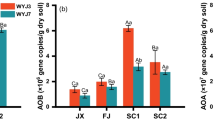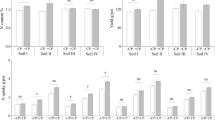Abstract
Aims
We examined differences in soil metabolites from the rice root rhizosphere of long-term rice-rice-fallow (RRF) and rice-rice-rape (RRR) rotations, and examined the effects of 1,2-benzenediol on nitrogen-use efficiency (NUE) and rice growth.
Methods
The metabolite composition of rice rhizospheres was analyzed using the gas chromatography-mass spectrometry (GC-MS). A range of 0.2, 2.0 and 200 μmol L−1 concentrations of external 1,2-benzenediol were applied to examine their effects on rice growth, nitrate reductase (NR) and glutamine synthetase (GS) activities, and physiological nitrogen-use efficiency (PNUE).
Results
The metabolite composition of rhizospheres differed significantly between RRR and RRF. Soil total N and 1,2-benzenediol concentrations during the early rice season were significantly lower under RRR than RRF. Rice growth and NUE significantly enhanced at 0.20 μmol 1,2-benzenediol L−1, but inhibited at 2.0 μmol L−1 or higher. Changes in root morphology and uptake associated with 1,2-benzenediol possibly had contributed to a higher NUE of the early season rice under RRR. The NR and GS activities in rice roots were significantly higher with 0.2 μmol L−1 1,2-benzenediol than without 1,2-benzenediol treatment.
Conclusions
Crop rotation significantly affected rice rhizosphere metabolites. An optimal soil 1,2-benzenediol concentration under long-term RRR rotation may be associated with an enhanced NUE and root N uptake and assimilation, resulting in an increased rice growth and yield.







Similar content being viewed by others
References
Anderson JM, Park YI, Chow SW (1997) Photo inactivation and photo protection of photo system II in nature. Physiol Plant 100:214–223
Bais HP, Walker TS, Stermitz FR, Hufbauer RA, Vivanco JM (2002) Enantiomeric dependent phytotoxic and antimicrobial activity of (2)-catechin; a rhizosecreted racemic mixture from spotted knapweed (Centaurea maculosa). Plant Physiol 128:1173–1179
Bao SD (2000) Analytical methods of soil agro-chemistry. China Agriculture Press, Beijing (in Chinese)
Bhandari DR, Wang Q, Friedt W, Spengler B, Gottwald S, Römpp A (2015) High resolution mass spectrometry imaging of plant tissues: towards a plant metabolite atlas. Analyst 140:7696–7709
Bremner JM, Douglas LA (1971) Inhibition of urease activity in soils. Soil Biol Biochem 3:297–307
Chen W, Gong L, Guo Z, Wang W, Zhang H, Liu X, Yu S, Xiong L, Luo J (2013) A novel integrated method for large-scale detection, identification and quantification of widely-targeted metabolites: application in study of rice metabolomics. Mol Plant 6:1769–1780
Fan X, Jia L, Li Y, Smith SJ, Miller AJ, Shen Q (2007) Comparing nitrate storage and remobilization in two rice cultivars that differ in their nitrogen use efficiency. J Exp Bot 58:1729–1740
Fitzgerald MA, Mccouch SR, Hall RD (2009) Not just a grain of rice: the quest for quality. Trends Plant Sci 14:133–139
Frank T, Scholz B, Peter S, Engel KH (2011) Metabolite profiling of barley: influence of the malting process. Food Chem 124:948–957
Gao JS, Xu MG, Dong CH, Huang J, Cao WD, Zeng XB, Wen SL, Nie J (2013) Effects of long-term rice-rice-green manure cropping rotation on rice yield and soil fertility. Acta Agron Sin 39:343 in Chinese with English abstract
Glauser G, Marti G, Villard N, Doyen GA, Wolfender JL, Turlings TCJ, Erb M (2011) Induction and detoxification of maize 1,4-benzoxazin-3-ones by insect herbivores. Plant J 68:901–911
Gu Y, Chang ZZ, Yu JG, Zong LG (2013) Allelopathic effects of exogenous phenolic acids composted by wheat straw on seed germination and seedling growth of rice. Jiangsu J of Agr Sci 29:240–246 (in Chinese with English abstract)
Huang GQ, Xiong YM, Qian HY, Wang SB, Liu LW, Zhao QG (2006) Ecological analysis on crop rotation systems of paddy field. Acta Ecol Sin 26:1159–1164 (in Chinese with English abstract)
Jiang SF, Wang CJZ, Shu CW, Zhou EX (2018) Cloning and expression analysis of rsphm gene in rhizoctonia solani ag-1, a of rice sheath blight pathogen. Chin J Rice Sci 32:111–118 (in Chinese with English abstract)
Jom KN, Frank T, Engel KH (2011) A metabolite profiling approach to follow the sprouting process of mung beans (Vigna radiata). Metabolomics 7:102–117
Jose OS, Muraleedharan GN, Raymond H, Gene RS (1991) Significance of phenolic compounds in plant-soil-microbial systems. Crit Rev Plant Sci 10:63–121
Kato-Noguchi H, Ino T (2003) Rice seedlings release momilactone B into the environment. Phytochemistry 63:551–554
Liu P, Zhao HJ, Wan SB, Jiang LH, Yu SF, Yang L, Wang YQ, Li J (2010) Autotoxic potential of peanut (Arachis hypogaea) root exudates. Chinese Journal of Oil Crop Sciences 32:431–435 (in Chinese with English abstract)
Lu S, Zhang ZH (2018) Long-term rice-rice-rape rotation significantly improved soil structure and rice yield [J]. Chinese Journal of Soil Science 49(2):409–414 (in Chinese with English abstract)
Lu S, Lepo JE, Song HX, Guan CY, Zhang ZH (2018) Increased rice yield in long-term crop rotation regimes through improved soil structure, rhizosphere microbial communities,and nutrient bioavailability in paddy soil. Biol Fert Soils 54:909–923
Mazzei L, Cianci M, Musiani F, Lente G, Palombo M, Ciurli S (2017) Inactivation of urease by catechol: kinetics and structure. J Inorg Biochem 166:182–189
Mediene S, Valantin-Morison M, Sarthou JP, Tourdonnet SD, Gosme M, Bertrand M, Roger-Estrade J, Aubertot JN, Rusch A, Motisi N, Pelosi C, Dore T (2011) Agroecosystem management and biotic interactions: a review. Agron Sustain Dev 31:491–514
Olofsdotter M, Rebulanan M, Madrid A, Dali W, Navarez D, Olk DC (2002) Why phenolic acids are unlikely primary allelochemicals in rice. J Chem Ecol 28:229–242
Olsen RA, Brown JC, Benuen JH, Blume D (1982) Reduction of Fe3+ as it relates to Fe chlorosis. J Plant Nut 5:433–445
Panesar BS, Fluck RC (1993) Energy productivity of a production system: analysis and measurement. Agric Syst 43:415–437
Redinbaugh MG, Campbell WH (1998) Nitrate regulation of the oxidative pentose phosphate pathway in maize root plastids: induction of 6-phosphogluconate dehydrogenase activity, protein and transcript levels. Plant Sci 134:129–140
Rice EL, Putnam AR, Tang CS (1986) Allelopathic growth stimulation. In: The science of Allelopathy. John Wiley& Sons, New York, pp 23–42
Sato S, Soga T, Nishioka T, Tomita M (2004) Simultaneous determination of the main metabolites in rice leaves using capillary electrophoresis mass spectrometry and capillary electrophoresis diode array detection. Plant J 40:151–163
Shepherd LVT, Alexander CA, Sungurtas JA, McNicol JW, Stewart D, Davies HV (2010) Metabolomic analysis of the potato tuber life cycle. Metabolomics 6:274–291
Shilling DG, Yoshiiawa FA (1987) Seeding bioassay for the study of allelopathy in allelochemicals role in agriculture and forestry, Waller GR, Ed.. ACS Symp. Ser no. 330. American chemical society. Chap, Washington, D.C, p 31
Shu XL, Frank T, Shu QY, Engel KH (2008) Metabolite profiling of germinating rice seeds. J Agric Food Chem 56:11612–11620
Su W, Lu J, Wang W, Li X, Ren T, Cong R (2014) Influence of rice straw mulching on seed yield and nitrogen use efficiency of winter oilseed rape (Brassica napus L.) in intensive rice-oilseed rape cropping system. Field Crops Res 159:53–61
Toyomasu T, Kagahara T, Okada K, Koga J, Hasegawa M, Mitsuhashi W, Sassa T, Yamane H (2008) Diterpene phytoalexins are biosynthesized in and exuded from the roots of rice seedlings. Biosci Biotechnol Biochem 72:562–567
Voorde TFJVD, Putten WHVD, Bezemer TM (2011) Intra-and interspecific plant-soil interactions, soil legacies and priority effects during old-field succession. J Ecol 99:945–953
Wang H, Du NM (2006) Research and prospect of rice cropping system. Crop Res 5:498–503 (in Chinese with English abstract)
Watanabe K, Teramoto M, Futamata H, Harayama S (1998) Molecular detection, isolation, and physiological characterization of functionally dominant phenol-degrading bacteria in activated sludge. Appl Environ Microb 64:4396–4402
Wu CX, Li ZH, Shen YX (2007) Quantification and allelopathy potential of phenolic acids in aqueous extracts of legumes. Acta Agrestia Sintca 15:401–406 (in Chinese with English abstract)
Wu F, Yang N, Toure A, Jin Z, Xu X (2013) Germinated brown rice and its role in human health. Crit Rev Food Sci Nutr 53:451–463
Yu YL, Xue LH, Yang LZ (2014) Winter legumes in rice crop rotations reduces nitrogen loss, and improves rice yield and soil nitrogen supply. Agron Sustain Dev 34:633–640
Yuan DG, Wu JQ, Zhai HK, Wu QQ, Deng H, Xu GX, Luo Q, Wu DY, Wang CQ (2012) Activation effects of N, P, K fertilization and phenol on Si, AI, Fe in bleached paddy soil. Plant Nutrition and Fertilizer Science 18:771–776 (in Chinese with English abstract)
Zhang XX, Zhang RJ, Gao JS, Wang XC, Fan FL, Ma XT, Yin HQ, Zhang CW, Feng K, Deng Y (2017) Thirty-one years of rice-rice-green manure rotations shape the rhizosphere microbial community and enrich beneficial bacteria. Soil Biol Biochem 104:208–217
Zhou BM, Cui MY, Song JJ, Liu JL, Huang W, Yu GL, Liu RQ (2011) Effect of 1,2-benzenediol on the utilization rate of nitrogen fertilizer and rice yield. Modern Agricultural Science and Technology 17:248–252 (in Chinese with English abstract)
Acknowledgements
This study was supported in part by the National Key R&D Program of China (2017YFD0200100; 2017YFD0200104); National Natural Science Foundation of China (31101596, 31372130); Hunan Provincial Recruitment Program of Foreign Experts; the National Oilseed Rape Production Technology System of China; and the 2011 Plan of the Chinese Ministry of Education; and the Double First Class Construction Project of Hunan Agricultural University (kxk201801005).
Author information
Authors and Affiliations
Corresponding authors
Additional information
Responsible Editor: Andrea Schnepf.
Publisher’s note
Springer Nature remains neutral with regard to jurisdictional claims in published maps and institutional affiliations.
Highlights
• Crop rotation regimes affect the composition of rice rhizosphere metabolites
• Long-term rice-rice-rape rotation optimizes 1,2-benzenediol concentrations
• Nitrogen-use efficiency is improved by optimized 1,2-benzenediol concentrations
• Higher rice growth & yield are associated with optimized soil 1,2-benzenediol levels
Electronic supplementary material
ESM 1
(DOCX 463 kb)
Rights and permissions
About this article
Cite this article
Lu, S., Song, H., Guan, C. et al. Long-term rice-rice-rape rotation optimizes 1,2-benzenediol concentration in rhizosphere soil and improves nitrogen-use efficiency and rice growth. Plant Soil 445, 23–37 (2019). https://doi.org/10.1007/s11104-019-04177-9
Received:
Accepted:
Published:
Issue Date:
DOI: https://doi.org/10.1007/s11104-019-04177-9




